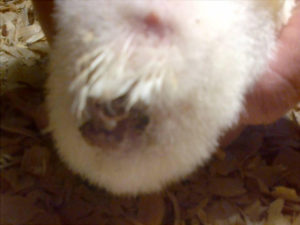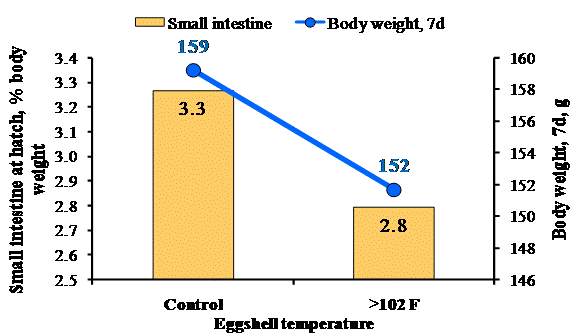Pasty Vents in Broiler Chickens
Sandro Cerrate, PhD
Credinser LLC, Madison, Alabama
Published: March 25, 2020
The occurrence of pasty vent is usually observed after 3 days of age when chicks are mainly depending on their feed rather than their yolk sac. Some chicken flocks present pasty vent more often than others, being their frequency variable and hard to track. How can it be prevented or treated? Could this characteristic damage the growth or feed conversion ratio at the market age? The pasty vents are produced because the cecal dropping has a sticky consistence and thereby not be released out completely when combined with the intestine excreta (Figure 1). Several factors can impact the composition of cecal content such as the heat stress conditions produced in the hatchery, transportation, and brooding period.
Ceca metabolism
The main function of the ceca is absorbing water from the intestinal digesta into the body. Therefore, during the process of panting for releasing out heat, the chicks not only lose water but also the cecal digesta loses water and becomes sticker due to an imbalance of ceca microorganisms. Of which these microbes transform fiber or long fatty acids into short fatty acids such as acetic, propionic, and butyric acids, for this reason any imbalance in the ecosystem will alter the digestion of fats and fibers. From what has been described, it is summarized that the pasty vent occurs when the digestion of fatty acids or fibers is reduced as well as the water content in the cecum. Any additive that facilitates the digestion of fatty acids or fibers and hydration in birds will help in the incidence of normal vents due to the proper cecal function.
Figure 1. Pasty vent.

Eggshell temperature
In commercial farms, chicks from higher eggshell temperature (>102 oF) during the incubation and from higher brooding temperature will alter the cecal metabolism and increase the incidence of pasty vents. Likewise, it had been shown that these higher eggshell temperatures reduce the chick weights at hatch and at seven days, from 159 grams vs 152 grams (Figure 2; Lourens et al. 2005; Joseph et al. 2006; Leksrisompong et al. 2009; Molenaar et al. 2011); these seven grams of differences will become at market age around 50 grams. In particular, birds from high eggshell temperatures (> = 102 oF) reduced the body weight by 50 grams at 42 days (Molenaar et al. 2011) and also the small intestine (14-21d, Leksrisompong et al. 2007; 0-28d, Diaz et al. 2016). This last characteristic could negatively affect the absorption of nutrients such as fatty acids. It is good to notice that the relationship between higher temperature and pasty vents has been observed in the field without any scientific data to sustain this observation.
Figure 2. Effect of eggshell temperature on small intestine and body weight at seven days.

Note: Small intestine data from Leksrisompong et al., (2007) and average body weight at 7d from several studies as indicated in text.
Brooding temperature
During these modern days, it is not strange to observe that chicks during the first days of age are under panting conditions, which indicate that the chicks need less brooding heat. A series of studies between 2000s and 2010s suggests that the brooder temperature had been reduced as compared to those from the 1970s (Figure 3). For instance, in a study reported in 2016, chicks needed 27 oC for the first seven days to yield the best feed conversion (Candido et al. 2016), in contrast, chicks from an older study require between 31 oC to 35 oC for the best feed conversion (Harris et al. 1975). Thus, if the brooding conditions are not adjusted to avoid overheating during the first seven days, the incidence of pasty vent might be increased.
Figure 3. Brooding temperature and genetic.

Note: Brooding temperature during the first seven days which reported the best feed conversion ratio adjusted to similar body weight. Based from Harris et al. 1975; Renwick and Washburn, 1982; Deaton et al. 1996; May and Lott, 2000; Silva et al. 2009; Candido et al. 2016. The latter author published the air relative humidity between 55% and 65%.
Emulsifiers
One of the first articles in publishing the relationship between chick pasty vent and feed conversion ratio by adding an exogenous emulsifier under tropical climatic conditions was from Roy et al. (2010). In this article, the pasty vent incidence was reduced from 40% to 15% during the first 10 days of age, and also the feed conversion ratio and body weight at 39 days were improved from 1.86 to 1.77, and from 1,983 g to 2,035 g respectively in chicks fed 1% of emulsifier and 2.8-3.5% of palm oil (Figure 4). In this study, the high incidence of pasty vents might be exacerbated due to the tropical conditions, which under practical conditions its occurrence is usually smaller, <3%. Using the proportion of pasty vents and feed conversion ratio adjusted to similar body weight (FCRadj), the FCRadj of one point, 0.01, might be equivalent to 2% of the pasty vent. After this study, other researchers have also tested this particular exogenous emulsifier but without recording the incidence of the pasty vent.
In general, the emulsifiers improved the fat and fiber digestibility being more effective in terms of FCRadj (3-7 vs 8-10 points) in diets lower in energy content, -100 kcal/kg (Kaczmarek et al. 2015; Zhao and Kim, 2017), because the fat and fiber were more digested in diets with lower energy content. Particularly, in chickens fed emulsifiers the fiber digestibility was increased by 6%, from 6.6% to 12.4%, in diets with standard energy content, but improved even more, by 15%, from 3% to 18% when the energy content was reduced by 100 kcal/kg (Kaczmarek et al. 2015). This better fiber digestion due to emulsifier suggests that the overall microbiota from the cecum is more active in breaking down the fiber into short fatty acids. If chicks with a high incidence of the pasty vent are observed during the first days of age, a good practice may be adding the emulsifiers as liquid form into the water system of the chicken house to ameliorate their negative effects.
Figure 4. Effect of emulsifier on pasty vent and feed efficiency.

Probiotics
The incidence of pasty vents had also been reduced from 26% to 11% during the first 14 days in chickens fed lactobacillus (de Cesare et al. 2017). In this research, the addition of lactobacillus improved statistically the feed conversion ratio by 0.02 hundredth, or two points of conversion (Figure 5). The lactobacilli or benefit probiotics facilitate the degradation of fatty acids and fiber into short fatty acids helping the cecal metabolism. Further, the addition of lactobacillus will increase the production of endogenous acidifiers as acetic acid, propionic acid, lactic acid, and butyric acids, which are also called short fatty acids, volatile acids, or organic acids. This abundance of organic acids in the intestine will reduce the intestinal pH, enhancing the intestinal nutrient absorption, and at the same time decreasing the population of pathogenic microorganisms such as Clostridium perfringens. This latter microorganism deactivates the bile acids decreasing their natural fat emulsifier properties (Knarreborg et al. 2002), thereby reducing the fat absorption and conversion toward short fatty acids.
Hence, additions of exogenous acidifiers, prebiotics as oligosaccharides, essential oils as thymol and carvacrol, or exogenous fiber enzyme (Hassan et al. 2010; Hashemipour et al. 2016; Ding et al. 2018; Ten and Kim, 2018), might also help in reducing the pathogenic microorganisms and increasing the lactobacillus, volatile fatty acids, and possibly the clean vents in chicks. Despite the probiotics, as lactobacillus have been scientifically tested in reducing the occurrence of the pasty vent, the potential reduction of pasty vents from other additives such as exogenous fiber enzymes, prebiotics, and acidifiers have not been tested scientifically. However, in the field adding acidifiers (acetic acid) has reduced the incidence of pasty vents.
Figure 5. Effect of Lactobacillus on pasty vent and feed efficiency.

Conclusions:
- Higher eggshell temperatures (>102 oF) and brooding temperatures will alter the cecal metabolism reducing the cecal water content, fat and fiber digestion; which also increases the chance of pasty vent.
- Adding exogenous emulsifiers will improve the fat and fiber digestion and thereby reducing the past vent incidence.
- Adding probiotics will improve the fat digestion and stimulate the natural production of volatile fatty acids producing a reduction of pasty vents. Moreover, other additives as exogenous enzyme fiber, prebiotics, acidifiers, and essential oils will help in the ceca metabolism, preventing a potential incidence of pasty vents.
References:
Conflict of Interest and disclaimer
The author declares that this article was conducted in the absence of any commercial or financial relationships that could be construed as a potential conflict of interest. Every attempt has been made to ensure that the material in this article is accurate, true, correct, and relevant at the time of writing. However, the author accepts no liability for any omissions, damage, loss, or financial consequences of using this article.



La información presentada en este artículo es muy interesante y útil para tratar los pollitos empastados. Probablemente son los pollitos machos más susceptibles a condiciones de altas temperaturas durante la incubación o los primeros días de crianza ya que se observa una mayor incidencia de empastamiento en ellos.